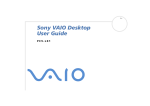Download Sony PCV-RXA842 User's Guide
Transcript
Welcome Thank you for purchasing your Sony VAIO® computer! Your new computer is a superb blend of high technology and easy-to-use functionality. The information provided here is designed to help you to become familiar with the hardware and software applications included with your system. View the Latest Updates for your computer. View the VAIO® Computer Specifications, which describes your computer's hardware configuration and preinstalled software information. Page 1 Getting Started Congratulations on your purchase of the Sony VAIO® computer! Your new, high-performance, multimedia computer combines audio, video, and information technology features. Unpacking Your Computer Planning An Ergonomic Work Space Locating Controls And Ports Setting Up Your Computer Turning On Your Computer Registering Your Computer Setting Up Your Dial-up Connection Turning Off Your Computer Page 2 Unpacking Your Computer Your computer may not be supplied with all of the accessories shown, depending on the system configuration you purchased. For details on the accessories supplied with your computer, see the online Specifications sheet. Com puter and supplied accessories Manuals VAIO® Com puter Quick Start — Provides basic information on setting up and registering your computer. The Quick Start also provides software, support, safety and legal information. VAIO® Com puter User Guide — Contains information on the hardware and preinstalled software applications included with your system. To access the online manual: 1. Click Start in the Windows taskbar, then click Help and Support. 2. From the VAIO Help and Support Center menu, click VAIO User Guide. Specifications — This online specification sheet describes the hardware and software configuration of your VAIO computer. To view this online information: 1. Click Start in the Windows taskbar, then click Help and Support. 2. From the VAIO Help and Support Center menu, click VAIO User Guide. 3. Click the Welcome link. The Welcome page displays in the right-side frame. 4. Click the link in the text, "View the VAIO Computer Specifications, which lists your computer's hardware configuration and preinstalled software information." Microsoft® Windows XP® Guide — Explains how to use the basic features of the latest Windows operating system. Recovery CDs System Recovery CD(s) — Restore the software applications that shipped with your computer if they become corrupted or are erased. The supplied System Recovery CDs can only be used to restore the hard disk of this Sony computer. Application Recovery CD(s) — Reinstalls individual software applications or drivers if they become corrupted or are erased. Other Packet containing special product offers. Software Library containing the Microsoft software license agreement and Sony end-user license agreement. Page 3 Planning An Ergonomic Work Space Before you get started, find the best location for your new computer. Planning your workspace Stable work surface — Use a stable work surface large enough to support the computer and other peripheral equipment. Ventilation — Leave at least eight inches of space on the left and back sides of your computer to enable proper ventilation. Placement of the keyboard, mouse, and other input devices — Place your keyboard, mouse, and other input devices so that your arms and hands are in a relaxed, comfortable position. The keyboard should be directly in front of you. Adjust the level of the keyboard so that your lower arms are parallel to the floor. Keep your wrists in a relaxed position when you are using the keyboard—not angled up or down. Use the palmrest only briefly, for resting. Position the mouse at the same level as the keyboard. Hold the mouse with a relaxed hand, and use your whole arm to move it. Take breaks during sessions with your computer. Excessive use of the mouse or a joystick may strain muscles or tendons. Furniture and posture — Sit in a chair with good back support and armrests. Adjust the level of the chair so your feet are flat on the floor. A footrest may make you more comfortable. Sit with relaxed, upright posture—avoid slouching forward or leaning far backward. Viewing angle of the display — Position the display 18 to 26 inches directly in front of you, with the top of the screen at or a little below eye level. Use the display's tilting feature to find the best position. You can reduce eye strain and muscle fatigue by placing the display in the proper position. Lighting — Choose a location where windows and lights do not create glare and reflection on the display. Use indirect lighting to avoid bright spots on the display. You can also purchase accessories for your display that help reduce glare. Proper lighting adds to your comfort and work effectiveness. Page 4 Locating Controls And Ports This section is intended to familiarize you with the controls, ports and jacks that may be available on your computer. Your computer may not be equipped with all of these hardware features and the location of the controls, ports, and jacks may vary from the illustrations shown in this section. To view the specific connection capabilities for your system, see the online specifications sheet. i.LINK is a trademark of Sony used only to designate that a product contains an IEEE 1394 connection. The i.LINK connection may vary, depending on the software applications, operating system, and compatible i.LINK devices. All products with an i.LINK connection may not communicate with each other. Please refer to the documentation that came with your compatible i.LINK device for information on operating conditions and proper connection. Before connecting compatible i.LINK devices to your system, such as an optical or hard disk drive, confirm their operating system compatibility and required operating conditions. Page 5 About the front panel The front panel of your VAIO Computer enables access to the optical and floppy disk drives. It also includes access to the Memory Stick media slot, Universal Serial Bus (USB), and i.LINK® ports to connect compatible peripheral devices. Front panel 1 Optical drive 1 See the online specifications sheet for optical drive information. 2 Optical drive 2 See the online specifications sheet for optical drive information. 3 Floppy disk drive Reads and writes data from and to a 3.5-inch floppy disk. 4 Floppy disk drive access indicator Light is green while reading and writing data from and to a floppy disk. 5 Optical drive access indicator Light is amber while reading and writing data from and to the optical drives. 6 Hard disk drive access indicator Page 6 Light is amber while reading and writing data from and to the hard disk. 7 Power switch and power indicator The power switch turns the computer on/off. The indicator light is blue while the power is on and amber when the computer is in Stand by mode. 8 i.LINK 4-pin port (IEEE 1394) Connection for a compatible digital device. 9 Optical drive 1 eject button Ejects a disc from Optical drive 1. 10 Optical drive 2 eject button Ejects a disc from Optical drive 2. 11 Memory Stick® media slot Reads and writes data from and to a Memory Stick® media. 12 Floppy disk eject button Ejects a floppy disk. 13 Universal Serial Bus 2.0 (USB) ports (2) High-speed connections for compatible USB devices. For your convenience, your computer includes USB and i.LINK ports on both the front and back panels. The 4-pin i.LINK port is located on the front panel and the 6-pin i.LINK port is located on the back. Page 7 About the back panel The back panel of your computer contains the ports for supplied and optional accessories. The icons on the back panel locate and identify the ports and jacks on your computer. Your system may vary based on the configuration you purchased. Back panel 1 Mouse port Connection for a PS/2® mouse. 2 Keyboard port Connection for a PS/2 keyboard. 3 Printer port Connection for a parallel device, such as a printer or scanner. 4 Monitor port (The monitor port location may vary between models) Connection for a display. 5 i.LINK 6-pin port (IEEE 1394) Connection for a compatible digital device. Page 8 6 Universal Serial Bus 2.0 (USB) ports (2) High-speed connections for compatible USB devices. 7 Microphone jack Connection for a microphone (optional). Headphones jack Connection for the supplied speakers or optional headphones. Line In jack Connection for an audio device. 8 Monitor port (The monitor port location may vary between models) Connection for a standard display. 9 Monitor (DVI) port (DVI port is not available on all models) Connection for a DVI monitor. 10 Telephone jack Connection for a telephone cable (optional) to the computer. 11 AC Input port Connection for the supplied power cord. 12 Ethernet port Connection for a 10BASE-T/100BASE-TX Ethernet interface. (The port marked with only.) 13 (Network) is for LAN connections Modem line jack Connection for the modem cable to the wall jack. Page 9 Setting Up Your Computer Your computer may not be equipped with all of these hardware features and the location of the controls, ports, and jacks may vary from the illustrations shown in this section. See the online specifications sheet for your system's configuration. Page 10 Connecting a display (monitor) 1. Plug the display cable into the Monitor port. 2. If necessary, plug the display cable into the rear of the display. To connect a display Install your equipment so that you can easily reach the power outlet in the event of an emergency. Page 11 Connecting the speakers 1. Plug the cable attached to the back of the left speaker into the L Out jack on the back of the right speaker. 2. Plug the cable attached to the back of the right speaker into the Headphones jack. 3. Plug the jack end of the AC adapter cord into the DC In jack on the back of the right speaker and plug the other end into a grounded AC wall outlet or power strip. To connect the speakers Page 12 Connecting the keyboard and mouse 1. Plug the keyboard cable into the Keyboard port on the back of the computer. 2. Plug the mouse cable into the Mouse port. To connect the keyboard and m ouse Page 13 Connecting the modem cable 1. Unplug your telephone from the wall jack. 2. Plug the modem cable (supplied) into the Modem line jack on the computer, and then plug the other end of the cable into the wall jack. To connect the m odem cable Your computer has a protective sticker covering the Ethernet port located on the rear panel. Connect only 10BASE-T and 100BASE-TX cables to the Ethernet port. Using other cables or a telephone cable may result in an electric current overload and can cause a malfunction, excessive heat or fire in the port. For help on connecting to a network, see your network administrator. Page 14 Connecting the power cords 1. Plug the power cord into the back of the computer. 2. Plug both the display and power cords into a grounded AC wall outlet or a power strip. To connect the power cords Page 15 Turning On Your Computer When you start your system for the first time, your computer may detect new equipment and display a dialog box that prompts you to restart your computer. Respond to this prompt immediately. 1. Press the power switch on the computer to turn on the power. 2. Press the power switch on the display to turn on the power. 3. Press the power switch on the right speaker to turn on the power. To turn on your com puter Page 16 Registering Your Computer Take advantage of Sony's commitment to quality customer support and receive these benefits by registering your computer: Sony Customer Support — Communicate with a Support Representative to troubleshoot problems you may be having with your computer. Limited warranty — Protect your investment. See the Warranty Card for more details. You are prompted to register your computer the first time you turn on the unit. Follow the on-screen instructions to complete the registration process. If you are not able to register your computer during the first session, you are provided with additional registration opportunities later. Page 17 Setting Up Your Dial-up Connection The first time you turn your computer on, follow these steps to set up your dial-up connection: 1. Click Start from the Windows taskbar and select All Programs. 2. Point to Accessories, point to Communications, and then click New Connection Wizard. The Location Information window appears. Location Inform ation window 3. Enter in your information as requested. Click OK. The Phone and Modem Options window appears. Phone and Modem Options window 4. Click to select your dialing location and then click OK. The New Connection Wizard appears. New Connection Wizard window Page 18 5. Follow the on-screen instructions to finish setting up your dial-up connection. Page 19 Turning Off Your Computer Follow these steps when you are ready to turn off your computer for an extended period of time. To avoid loss of data, do not use the Power switch to turn off the computer. To turn off your computer 1. Click Start in the Windows taskbar, then select Turn Off Computer. The Turn Off Computer dialog box appears. 2. Select the Turn Off option. Respond to any prompts about saving your documents. 3. Wait for your computer to turn off automatically—the power indicator light turns off. 4. Turn off any peripheral devices connected to your computer. If you plan to turn off your computer for a short period of time, you may want to use Stand by mode instead. About the power switch If your system stops responding, press and hold the Power switch for more than six seconds to force your system to shut down. You may need to repeat this procedure if your system does not shut down on the first attempt. Page 20 Configuring Your VAIO Computer This section provides basic information about managing your computer's hard disk drive performance, using i.LINK devices, Memory Stick media, PC Cards, and changing default settings. Your computer may not be equipped with all of the hardware features described in this section, depending on the system configuration purchased. To view the specific hardware configuration for your computer, see the online specifications sheet. About Your Hard Disk Drive Partition i.LINK Compatibility VAIO Action Setup Changing The Sony Software Window Design Using The Memory Stick Media Slot Using The PC Card Slot Page 21 About Your Hard Disk Drive Partition To improve the performance of Sony audio and video software applications, the hard disk drive on your computer has been formatted with two partitions, C and D. Some Sony software applications save files to the D partition. This prevents large video captures from consuming the available space on your C partition. To maintain optimum system performance, you should defragment your computer's D partition regularly. Page 22 Defragmenting your hard disk drive If you encounter frame dropping while recording digital video onto your hard disk drive, defragmentation may be necessary. 1. Deactivate your screen saver and close other open applications, if applicable. 2. Click Start in the Windows taskbar and select All Programs. 3. Point to Accessories, point to System Tools, and then select Disk Defragmenter. The Disk Defragment dialog box appears. 4. Select Action from the menu bar and click Analyze. It may take a long time to complete defragmentation, depending on the data capacity and current utilization of your computer's hard disk drive(s). Page 23 i.LINK Compatibility Your VAIO® computer may be equipped with a 4-pin and/or a 6-pin i.LINK port, depending on the system configuration purchased. A 4-pin i.LINK port cannot supply power to a connected i.LINK device. A 6-pin i.LINK port can supply power (10V to 12V) to a connected i.LINK device, if the device is equipped with a 6-pin connector. To view the specific hardware configuration for your computer see the online specifications sheet. The total power supplied by the 6-pin i.LINK port cannot exceed 6 watts. The following i.LINK 400 Mbps cables are available and recommended for use with your computer: VMC-IL4415, VMC-IL4435, VMC-IL4615, VMC-IL4635, VMC-IL6615, and VMC-IL6635. Sony computer supplies, accessories, and peripherals can be purchased from your local retailer, from the Sony VAIO Direct Web site at http://www.sonystyle.com. i.LINK is a trademark of Sony used only to designate that a product contains an IEEE 1394 connection. The i.LINK connection may vary, depending on the software applications, operating system and compatible i.LINK devices. All products with an i.LINK connection may not communicate with each other. Please refer to the documentation that came with your compatible i.LINK device for information on operating conditions and proper connection. Before connecting compatible i.LINK devices to your system, such as an optical or hard disk drive, confirm their operating system compatibility and required operating conditions. Page 24 Connecting an i.LINK (IEEE 1394) device 1. Use the symbol to locate the i.LINK port on your compatible i.LINK device and on your computer. Plug the i.LINK cable connector into this port. 2. Plug the other end of the cable into the corresponding 4- or 6-pin i.LINK port on your computer. See the instructions that came with your i.LINK device for more information on installation and use. Page 25 VAIO Action Setup VAIO® Action Setup manages the settings for your computer's Shortcut keys (S Keys). Shortcut Keys The programmable S Keys are set to launch the following applications: S1 — Microsoft® Outlook® Express S2 — Microsoft® Internet Explorer S3 — SonicStage S4 — PictureGear S5 — MovieShaker Studio S5 — Giga Pocket (On selected models equipped with Giga Pocket features.) S6 — VAIO® Help and Support Page 26 Changing the settings of the S keys You can reprogram the S keys to launch other applications. 1. Click Start in the Windows taskbar and select All Programs. 2. Select VAIO Action Setup, then click VAIO Action Setup. You can also double-click Setup. the VAIO Action Setup icon, located in the Windows taskbar, to launch VAIO Action 3. Click the S Key you want to change. 4. From the Select Application dialog box, click the option for the desired type of function. The corresponding applications appear in the list box on the right. 5. Select an application from the list. Click Next. You can drag an application to place it into the list box. 6. The Confirmation Application Name window appears. Click Next. 7. You may now type a new name and description, if desired. Then click Finish. Page 27 Changing The Sony Software Window Design You can select from different window designs for certain Sony software applications and create your own personal computing environment. Page 28 Changing the window design 1. Click Start in the Windows taskbar and select the Control Panel. 2. Click Other Control Panel Options. 3. Click UI Design Selector. 4. Click << or >> and select the desired design. 5. Click Apply. 6. The "UI Design Selector" window design changes. The window design for your Sony software will match the "UI Design Selector" window. 7. To try another selection, click << or >>, then click Apply. 8. When you have made your selection, click OK. The UI Design Selector closes and the Sony software window design displays. You may only use this feature with compatible UI Design Selector software. Page 29 Using The Memory Stick Media Slot Your computer may not be equipped with a Memory Stick® media slot as described in this section, depending on the hardware configuration purchased. To view the specific system configuration for your computer see the online specifications sheet. A Memory Stick media is a compact, portable, and versatile data storage media designed for exchanging and sharing digital data with similarly equipped products. To insert a Memory Stick media 1. Use your fingertip to pull open the upper front panel cover, as shown. Opening the front panel (PCV- RZ series m odel shown) 2. Insert the Memory Stick® media into the Memory Stick media slot. Inserting the Mem ory Stick Media (PCV- RZ series m odel shown) 3. If the media does not insert easily, remove it from the slot and verify that it is not upside-down or backwards. Page 30 Carefully reinsert the Memory Stick media, but do not force it into the slot. Do not remove the Memory Stick media while the media access indicator light is on. The media or its data may become damaged. To remove a Memory Stick media A small portion of the Memory Stick media remains extended when it is inserted into the Memory Stick media slot. 1. Press and release the extended portion of the Memory Stick media. The media extends out further from the slot. Rem ov ing the Mem ory Stick Media (PCV- RZ series m odel shown) 2. Remove the Memory Stick media from the slot carefully. Memory Stick media do not support AVI file playback. First copy the AVI file to your hard disk drive and then playback the file. To protect data on Memory Stick media from accidental changes Memory Stick media contain a write-protect tab. The write-protect tab prevents accidental changes to information recorded on your Memory Stick media. When you slide the write-protect tab to the LOCK position, your Memory Stick media is write-protected. You cannot delete, copy, or save information on the media while the write-protect tab in the LOCK position. When you slide the tab to the un-LOCK position, you can write to or modify your Memory Stick media's contents. Locking the Mem ory Stick Media Page 31 Using The PC Card Slot Your computer may not be equipped with a PC card slot as described in this section, depending on the hardware configuration purchased. To view the specific system configuration for your computer see the online specifications sheet. Your computer's PC card slot supports Type I or Type II PC (PCMCIA) cards. You do not need to shut down your computer when inserting a PC Card. For more information, see the instructions supplied with your PC Card. To insert a PC Card 1. Use your fingertip to pull open the lower front panel cover, as shown. Opening the lower front panel (PCV- RZ series m odel shown) 2. With the label facing up, insert the PC Card into the PC Card slot. Inserting a PC Card 3. Push the PC Card gently into the slot. The card is automatically detected and the icon appears in the Windows® taskbar. Safely Remove Hardware If the PC Card does not insert easily, remove it from the PC Card slot and verify that it is not upside-down or backwards. Carefully reinsert the PC Card, but do not force it into the slot. To remove a PC Card Page 32 1. Close all applications that may access the PC Card to avoid data loss. 2. Double-click the Safely Remove Hardware icon in the Windows® taskbar. 3. Click to select the name of the card that you want to eject and click Stop. The Stop a Hardware Device window appears. Click OK. 4. When the message "Safe to Remove Hardware" appears, push the PC Card Eject button on the front panel of the system unit. You may need to extend the Eject button out from the computer before you can eject the card. Rem ov ing a PC Card (PCV- RZ series m odel shown) 5. When the PC Card ejects from the PC Card slot, remove it by holding the edges and pulling it out carefully. If you eject the PC Card incorrectly, your computer may not work correctly. Page 33 Setting up the remote control Your computer may not be supplied with the remote control, depending on the hardware configuration purchased. A remote control is only supplied with computers that are equipped with Giga Pocket hardware features. To view the specific system configuration for your computer, see the online specifications sheet. Insert two AA batteries (supplied) into the remote control as shown in the illustration. Inserting batteries into the rem ote control Under normal use, the AA batteries may last up to six months. If your remote control does not operate properly, the batteries may need to be replaced. If your remote control is not being used for extended periods of time, remove the batteries to avoid possible damage from battery leakage. Page 34 Upgrading And Maintaining Your VAIO Computer In the future you may want to increase the functionality of your VAIO computer. This section describes how to perform basic upgrades and maintenance on your system. For more information on upgrading your computer, see the computer's System Reference Manual. You can download the System Reference Manual from the Sony Web site at http://www.sony.com/pcsupport. Overview Removing the Side Panel Installing an Add-on Card Installing Memory Replacing the Lithium Battery Installing an Additional Hard Disk Drive Replacing the Side Panel Page 35 Overview The procedures in this section assume that you are familiar with the general terminology associated with personal computers and with the safety practices and regulatory compliance required for using and modifying electronic equipment. Your computer may not be equipped with all of the hardware features discussed in this section. The interior configuration may vary from the illustrations, depending on the system purchased. To view the specific hardware configuration for your computer, see the online specifications sheet. Before you upgrade your computer Disconnect the computer from its power source and from telecommunications links, networks, or modems before you open the unit or follow any of the procedures described in this section. Failure to do so may result in personal injury or equipment damage. Electrostatic discharge (ESD) can damage disk drives, add-on cards, and other components. Work at an ESD workstation when following the procedures described in this section. If such a station is not available, use these precautions: Avoid working in a carpeted area. Do not handle materials that may produce or hold static electricity, such as cellophane wrappers. Ground yourself by maintaining continuous contact with an unpainted metal portion of the chassis while performing the procedure. When removing a slot cover, avoid rough handling that may damage components on the system board or add-on cards. You may need to temporarily remove add-on cards that are near the slot cover you plan to remove. Electrostatic discharge (ESD) can damage disk drives, add-on cards, and other components. Follow the procedures described here only at an ESD workstation. If such a station is not available, do not work in a carpeted area and do not handle materials that produce or hold static electricity (for example, cellophane wrappers). Ground yourself by maintaining continuous contact with an unpainted metal portion of the chassis while performing the procedure. Always turn the power off before you open the system or connect your computer to peripheral equipment. Otherwise, damage may occur to the integrated circuits in your computer. Page 36 Removing the Side Panel To remove the side panel 1. Shut down your computer and turn off all peripheral devices, such as your printer. 2. Unplug your computer and any peripheral devices. 3. Locate the tab on the upper right side of the rear panel, and pull it back until the side panel releases. 4. Lift the side panel away from the unit and set aside. Rem ov ing the side panel If you remove the side panel immediately after you shut down your computer, the components may be too hot to touch. Wait until the internal parts of the system unit cool down before you attempt to remove the side panel. Page 37 Installing an Add-on Card Your computer may have one or more open expansion slots, depending on the model configuration. An expansion slot enables you to install add-on cards to expand the functionality of your system. The length of the add-on card should not exceed 9.05 inches. Add-on card configuration varies by model. Some models, such as Configure-to-Order (CTO) systems, may contain preinstalled add-on cards. Observe the proper safety precautions when you add cards to your Sony computer. See Before you upgrade your computer. To install an add-on card 1. Shut down your computer and turn off all peripheral devices, such as your printer. 2. Unplug your computer and any peripheral devices. 3. Remove the side panel. See To remove the side panel. 4. Locate an available expansion slot. Remove the slot cover's screw, and then remove the slot cover. When removing a slot cover, be careful not to damage components on the system board or add-on cards. You may need to temporarily remove add-on cards or other components that may be next to the slot cover you want to remove. Rem ov ing the slot cov er 5. Install the add-on card by inserting it into the expansion slot and securing it with the screw from the expansion slot cover. Installing an add- on card 6. Attach any internal cables that the card requires. See the instructions supplied with the add-on card. 7. Replace the side panel. See To replace the side panel. Page 38 8. Reconnect all peripheral devices and the power cord, and then turn on the computer. Page 39 Installing Memory The amount of preinstalled memory may vary, depending on the system configuration you purchased. Your computer may ship with all available memory slots filled. See the online specifications sheet for details about the amount of memory installed in your computer. For memory replacement or upgrades, use only 2.5 V, 64-bit, PC2100 DDR-SDRAM Dual InLine Memory Modules (DIMM). You can purchase additional memory modules, accessories, and peripheral equipment from your local retailer. Observe the proper safety precautions when you add or remove the memory in your computer. See Before you upgrade your computer. To remove memory 1. Shut down your computer and turn off all peripheral devices, such as your printer. 2. Unplug your computer and any peripheral devices. 3. Remove the side panel. See To remove the side panel. 4. Gently place the unit on its side. If necessary, remove any cables, add-on cards, or other components to access the DIMM slots. 5. Locate the memory module(s) you wish to remove. 6. Push down on the latches located on both sides of the module to gently eject it from the slot. 7. Grasp one edge of the module and lift it out. Store the module in a static-free bag. Rem ov ing/Installing m em ory To install memory 1. Shut down your computer and turn off all peripheral devices, such as your printer. 2. Unplug your computer and any peripheral devices. 3. Remove the side panel. See To remove the side panel. 4. Gently place the unit on its side. If necessary, remove any cables, add-on cards, or other components to access the DIMM slots. 5. Remove the power supply before installing the memory module(s), by following these steps: 1. Remove the screw that secures the power supply unit to the chassis. Page 40 2. Pull the tab that releases the power supply from the chassis. 3. Slide the power supply unit up until it clears the chassis. 4. Rotate the power supply to an upside down position and rest it on top of the chassis. 6. Handle the DIMM only by the edges, and remove it from its anti-static package. 7. Locate the notches on the bottom edge of the module. 8. Align the module over the slot. 9. Firmly insert the bottom edge of the DIMM into the slot. 10. Press down evenly against the module's upper corners. The end latches snap into position, holding the module in place. To avoid damaging a DIMM slot, move the end latches slightly outward to relieve pressure. The module clicks into place. 11. Reinstall any components or add-on cards you may have removed. 12. Reinstall the power supply by following these steps: 1. Rotate the power supply unit to its original position and slide it into the chassis until the tab snaps into position. 2. Replace the screw that secures the power supply to the chassis. 13. Replace the side panel. See To replace the side panel. Page 41 Replacing the Lithium Battery The lithium battery starts to weaken after several years and the system settings, such as the date and time stored in CMOS RAM, may become inaccurate. Replace the lithium battery when this occurs. There is danger of the battery exploding if it is replaced incorrectly. Replace the battery only with a CR2032-type lithium battery. To replace the lithium battery 1. Write down any changes you may have made to the settings in the BIOS Setup utility. 2. Shut down your computer and turn off all peripheral devices, such as your printer. 3. Unplug your computer and any peripheral devices. 4. Remove the side panel. See To remove the side panel. 5. If necessary, remove any cables, add-on cards, or other components to access the lithium battery. 6. Remove the old battery and install the new battery with the plus (+) side up. Installing a lithium battery 7. Replace the side panel. See To replace the side panel. The values stored in the CMOS memory are now reset to the factory default values. Run the Setup utility to reset the date, time, passwords, and other changes you may have made to the BIOS settings. If you do not wish to customize your BIOS settings, do not run the Setup utility. Dispose of the lithium battery properly. In some areas, the disposal of lithium batteries in household or business trash may be prohibited. You can return your unwanted lithium batteries to your nearest Sony Service Center or Factory Service Center. To locate a Service Center near you, visit the Sony Computing Support Web site at http://www.sony.com/pcsupport. To reset your computer's date and time, see VAIO Help and Support Center for instructions. To access the VAIO Help and Support Center: 1. Click Start in the Windows ® taskbar, then click Help and Support. 2. The VAIO Help and Support Center window appears. Page 42 Installing an Additional Hard Disk Drive Your computer comes with an available internal bay to hold a second standard 3.5-inch hard disk drive. Some models, such as Configure-to-Order (CTO) systems, may already have a second hard disk drive installed. Your system can support ATA-33, ATA-66, or ATA-100 hard disk drives. Sony recommends using an ATA-100 hard disk drive to take full advantage of your system's features. The hard disk drive access light blinks when either internal drive is active. For detailed information about installing additional drives, see the System Reference Manual. You can download the System Reference Manual from the Sony Computing Support Web site at: http://www.sony.com/pcsupport. 1. Click on PC - Desktops and click to select the appropriate model series from the submenu. 2. Click the link for your computer model number. The model-specific support page appears. 3. Under Documentation, click System Reference Manual or System Reference Guide. Make sure you observe the proper safety precautions when you upgrade your Sony computer. See Before you upgrade your computer. To install an additional hard disk drive 1. Shut down your computer and turn off all peripheral devices, such as your printer. 2. Unplug your computer and any peripheral devices. 3. Remove the side panel. See To remove the side panel. 4. Configure the jumpers on the new drive as a slave. See the configuration instructions supplied with your drive. 5. Detach the power and drive cables from the original hard disk drive that is preinstalled in your computer. 6. Unlock the drive holder from the chassis by pulling down on the tab located at the bottom of the drive holder and then slide the drive holder out. Rem ov ing the driv e holder 7. Slide the new drive into the drive holder and align the holes on each side of the drive bay. Attaching the driv e screws Page 43 8. Secure the drive to the drive holder with screws, through the two holes on each side of the drive holder. Your new hard disk drive is supplied with the necessary screws. Do not overtighten these screws when securing the drive to the drive holder. 9. Align the drive holder with the slots on the inside of the chassis and slide the drive holder in completely. 10. Push up on the bottom tab of the drive holder to lock it into position. 11. Connect the second drive connector to the new drive. Orient the connector to align pin 1 on the red side of the ribbon cable with pin 1 on the new drive. 12. Connect the second power connector to the new drive. See the instructions supplied with the drive. Replacing the driv e holder 13. Replace the side panel. See To replace the side panel. 14. Reconnect the power cord to your computer. To identify additional hard disk space When you initialize the new hard disk drive, it must be configured as an extended partition in Windows NT file system (NTFS) format. 1. Log on to Windows ® as Administrator. 2. Click Start in the Windows taskbar, then right-click My Computer. A shortcut menu appears. 3. Select Manage. The Computer Management window appears. 4. Under the file directory on the right, go to Storage and then select Disk Management. 5. Right-click on the newly installed, unformatted drive (Disk label identified with red marking), and from the shortcut menu, select Initialize Disk. 6. Click on the Unallocated area of the drive and then right-click to display a shortcut menu. 7. Select New Partition. The New Partition wizard appears. Page 44 8. Follow the wizard's instructions to complete the process. The Windows ® XP operating system recognizes the new hard disk drive and applies the NTFS format. Page 45 Replacing the Side Panel To replace the side panel 1. Align the tabs on the side panel to the chassis rim. 2. Press the side panel firmly against the unit until it snaps into place. Replacing the side panel Page 46 System and Application Recovery CD(s) You can restore your system, individual software applications, or drivers, using the Recovery CDs. Using The System Recovery CD(s) Using The Application Recovery CD(s) Page 47 Using The System Recovery CD(s) The System Recovery CD utility formats your hard disk drive and restores the operating system and all the original, preinstalled software applications. If the operating system or applications become corrupted or are erased, you can restore your computer to the original factory settings. The System Recovery CD can only be used to restore the hard disk drive of the Sony computer you purchased. The System Recovery process removes all software that you may have installed since you started using your computer. Reinstall any applications that were not included with the computer when you purchased it. If you experience a problem with your computer, reinstalling an individual application or device driver may correct the problem. You may not need to recover the entire contents of your hard drive. Use the Application Recovery CD(s) to reinstall individual applications. When you successfully complete your system recovery, you are prompted to complete the Windows registration process. Page 48 System Recovery options Default System Drive Recovery (Recommended) All data on Drive C is deleted. The factory default settings and software applications are restored on this drive only. Change partition size and recover All partitions, custom installations, and changes are removed from the hard disk drive. You can set the partition sizes for both the Drive C and Drive D. The original, preinstalled operating system and software applications are restored. Factory Default Settings Recovery All data and partitions are removed from the hard disk drive. All original factory settings, operating system, and preinstalled software are restored. The System Recovery utility does not back up your system's data. If you wish to retain your system data, perform a back up to an external media. Page 49 Using the System Recovery CD(s) Your system may take a few minutes to load necessary files. A blue screen appears during the downloading process. 1. Press the disc eject button to open the optical disc drive and extend the disk tray. 2. Insert the System Recovery CD (CD #1) in your computer's optical drive. 3. Press the disc eject button to close the optical disk drive tray. The System Recovery utility starts from the optical drive. The first CD must be in the drive when you turn on your computer. Inserting the System Recov ery CD (PCV- RZ series m odel shown) If your system is equipped with two optical drives, insert the System Recovery CD into the upper optical drive. 4. Turn off your computer. 5. Wait 30 seconds and turn on your computer. Your screen displays the downloading progress, "Starting VAIO Recovery Utility." 6. When the VAIO System Recovery Utility dialog box appears, click Next. 7. The Notes on Use window appears. Click Next. 8. On the Main Menu - Product Recovery window, select the appropriate option to recover your system. Follow the on-screen instructions to complete the recovery process. Your system may include one or more System Recovery CDs. If you have more than one System Recovery CD, insert the first CD to run the System Recovery program. You are prompted to insert the next CD(s) once the information from the first CD has been installed. The recovery process takes approximately 30 to 60 minutes to complete. After recovering your system using the System Recovery CD(s), you may be prompted to insert your Application Recovery CD(s) after restarting Windows. Use the Application Recovery CD(s) to complete full restoration of your system. Page 50 Using The Application Recovery CD(s) The Application Recovery CD utility enables you to reinstall individual software, individual drivers, and to repair software if they become corrupted or are erased. You can reinstall a software application or driver to correct a problem that you are experiencing with your computer, peripheral hardware, or specific software. You may not need to reinstall the entire contents of your hard drive. You must be in Windows to run the Application Recovery CD utility. To reinstall all of the software that shipped with your computer, use the System Recovery CD(s). Page 51 Reinstalling software 1. Turn on your computer. If your computer is already on, save and close all open applications. 2. Logon to go to the Windows ® desktop. 3. Insert Application Recovery CD #1 into your computer's optical drive. The Application Recovery utility loads automatically. If your system is equipped with two optical drives, insert the Application Recovery CD into the upper optical drive. 4. Click OK in the VAIO welcome window. The Sony Application Recovery Program window appears. 5. Double-click the Software folder. Icons representing preinstalled software are displayed. 6. Double-click the application you want to reinstall. The software's installation wizard begins. 7. Follow the on-screen instructions to complete the application recovery process. If you have questions about using the Application Recovery CD(s), visit the Sony Computing Support Web site at http://www.sony.com/pcsupport. Page 52 Reinstalling device drivers The Microsoft® Windows ® XP operating system is capable of reinstalling the original factory-installed device drivers, without using the Application Recovery CD(s). 1. Click Start in the Windows taskbar, then right-click My Computer. A shortcut menu appears. 2. Click Properties. The System Properties dialog box appears. 3. From the Hardware tab, click the Device Manager button. 4. Right-click to select the unknown device1 or the device that requires the driver installation and click Update Driver from the shortcut menu. The Hardware Update Wizard appears. 5. Follow the on-screen instructions to locate the device and reinstall the appropriate device driver. If Windows XP does not reinstall the device driver(s), follow the steps in the next section to reinstall the device driver(s) using the Application Recovery CD(s). 1 A n unknown devic e(s ) is identified by a yellow ques tion mark. A devic e that has a driver problem is identified by a yellow exc lamation mark. Page 53 Reinstalling device drivers using Application Recovery CD(s) 1. Logon to go to the Windows ® desktop. 2. Insert Application Recovery CD #1 into the optical disc drive. The VAIO welcome window appears. Click OK, then click Quit to close the Sony Application Recovery utility. 3. Without removing the Application Recovery CD from the optical drive, click Start in the Windows taskbar and then right-click My Computer. A shortcut menu appears. 4. Click Properties. The System Properties dialog box appears. 5. From the Hardware tab, click the Device Manager button. 6. Right-click to select the unknown device or the device that requires the driver installation and click Update Driver from the shortcut menu. The Hardware Update Wizard appears. 7. Click to select the option, Install from a list or specific location (Advanced). Click Next. 8. Click to cancel the option, Search removable media (floppy, CD-ROM...). 9. Select the check box for Include this location in the search and click Browse. The Browse for Folder dialog box appears. 10. Navigate to the optical drive and click to select the Application Recovery CD. The CD contents are displayed. 11. Click to open the drivers folder and click the folder for the device you want to reinstall. 12. Click OK to return to the Hardware Update Wizard. Click Next. 13. Select the device folder, and click Next. The Microsoft® Windows ® XP operating system automatically reinstalls the device driver(s) from the Application Recovery CD. 14. Click Finish and remove the Application Recovery CD from the optical drive. 15. Click Start in the Windows taskbar, select Turn Off Computer. The Turn Off Computer dialog box appears. 16. Select the Turn Off option. 17. Wait 30 seconds, and turn on your computer. Your system includes one or more Application Recovery CDs. Insert Application Recovery CD #1, to start the application or driver recovery process. You are prompted to insert the next CD(s), depending on the software application or driver you wish to restore. Page 54 Troubleshooting This section describes how to troubleshoot common problems. You can also find helpful information on how to use your computer's hardware features and preinstalled software. Your computer may not be equipped with all of the features or software discussed in this section, depending on the system configuration purchased. About VAIO Computer Functions About Software About Using The Optical Disc Drive(s) About The Speakers About The Modem About The Microphone About The Mouse And Keyboard About Using Peripheral Equipment Page 55 About VAIO Computer Functions My computer does not start. Check that the computer is plugged into a power source and that it is turned on. Check that the power light is lit on the front panel of the computer. Confirm that a disk is not in the floppy disk drive (unless you are using a bootable floppy disk). Confirm that a CD is not in an optical drive (unless you are using a bootable CD). Confirm that the power cord and all cables are connected firmly. If you plugged the computer into a power strip or Uninterruptible Power Supply (UPS), make sure the power strip or UPS is turned on and working. Check that the monitor is plugged into a power source and turned on. Check that the brightness and contrast controls are adjusted correctly. See the manual that came with your display for details. Check that the computer is not in stand by mode. Page 56 About VAIO Computer Functions My computer does not start. Check that the computer is plugged into a power source and that it is turned on. Check that the power light is lit on the front panel of the computer. Confirm that a disk is not in the floppy disk drive (unless you are using a bootable floppy disk). Confirm that a CD is not in an optical drive (unless you are using a bootable CD). Confirm that the power cord and all cables are connected firmly. If you plugged the computer into a power strip or Uninterruptible Power Supply (UPS), make sure the power strip or UPS is turned on and working. Check that the monitor is plugged into a power source and turned on. Check that the brightness and contrast controls are adjusted correctly. See the manual that came with your display for details. Check that the computer is not in stand by mode. Page 57 Why did my computer or software application stop responding? You can try to locate and close the software application that has stopped responding. 1. Press the Ctrl+Alt+Delete keys. The Windows Task Manager window appears. 2. From the Applications tab, locate the application that has the status message, "Not responding." 3. Select the application that has a Not Responding status and click End Task. Windows attempts to close the application. If your computer does not respond or the application does not close, try the following steps: 1. Save any open files, if possible. 2. Press the Alt+F4 keys. The Turn Off Computer window appears. 3. Click Restart. If your computer still does not respond and you cannot restart, shut down your computer by pressing and holding the power switch for more than six seconds. If the software application continues to stop responding or causes your computer to stop responding, contact the software publisher or designated technical support provider. Pressing and holding the power switch for more than six seconds, may result in the loss of data from files that are currently open. Page 58 Why does the Windows operating system stop responding during shutdown? The Windows operating system may not shut down properly for many reasons, including incompatible or conflicting drivers, damaged files, or non-responsive hardware. For troubleshooting information, you can search Windows Help. 1. Click Start in the Windows taskbar and select Help and Support. The VAIO Help and Support Center menu appears. 2. Select Fixing a Problem and then select Startup and Shut Down problems. A list of specific problem topics appears on the right side of the dialog box. 3. Select Startup and Shutdown Troubleshooter. Follow the on-screen instructions according to your specific situation. Page 59 I cannot find the Windows taskbar. The Windows taskbar may be hidden or minimized. Use the mouse to locate a hidden taskbar by pointing to the left, right, top, and bottom edges of the screen. The taskbar appears when the cursor is placed over its location. 1. Right-click on the taskbar and select Properties from the shortcut menu. 2. Clear the check box for Auto-hide the taskbar, then click OK. Use the mouse to locate a minimized taskbar by pointing to the left, right, top and bottom edges of the display screen. The taskbar has been located when the cursor changes to a double arrow cursor. Left-click and drag away from the edge of the display screen. The minimized taskbar resizes and becomes visible. Page 60 Why is my system running slowly? The system responsiveness varies depending with the number of applications that are open and running. Close any applications that you are not currently using. Increasing the system memory may also help. For information on installing memory, please see the online VAIO User Guide. Page 61 How do I change the parallel port type to ECP, EPP, or bi-directional? You can change the parallel port type using the System Setup utility (CMOS Setup Utility). To access System Setup: 1. Click Start in the Windows taskbar and select Turn Off Computer. Select Restart. 2. When the Sony screen displays, press the F2 key on your keyboard. 3. Select the Advanced tab from the Setup Utility screen. 4. Select I/O Device Configuration and press Enter. 5. Use the arrow keys to highlight Parallel Port Mode and press Enter. You can toggle between the Normal (bi-directional), EPP, ECP, and ECP+EPP options using the directional arrow keys. 6. Select the desired setting displays, and press Enter. 7. Press the F10 key to Save and Exit. Page 62 Where can I find a listing of my computer's preinstalled software titles? You can find details about the drives, cards, and memory modules, that are installed on your system by viewing the online specifications sheet. This online document describes the hardware configuration of your VAIO computer. To access the online specifications sheet: 1. Click Start in the Windows ® taskbar and click Help and Support. 2. From the VAIO Help and Support Center menu, click VAIO User Guide. 3. Click the Welcome link. The Welcome page displays on the right. 4. Locate the link in the text, "View the VAIO® Computer Specifications," which describes your computer's hardware configuration and preinstalled software information. Page 63 About Software How do I create an audio CD with preinstalled Sony software? Your VAIO® computer has SonicStage software preinstalled on your computer. SonicStage is a digital music management software that enables you work with digital music from audio CDs and from the Internet. You can play music on your computer, create custom audio CDs, and check music out to compatible digital music devices. SonicStage software employs OpenMG copyright protection technology and advanced ATRAC3 you to enjoy digital music while protecting the rights of copyright holders. audio file format to allow To access SonicStage software Help 1. Click Start in the Windows taskbar, and click All Programs. 2. Point to SonicStage, and click SonicStage. 3. On the Help menu, click SonicStage Help. Page 64 About Software How do I create an audio CD with preinstalled Sony software? Your VAIO® computer has SonicStage software preinstalled on your computer. SonicStage is a digital music management software that enables you work with digital music from audio CDs and from the Internet. You can play music on your computer, create custom audio CDs, and check music out to compatible digital music devices. SonicStage software employs OpenMG copyright protection technology and advanced ATRAC3 you to enjoy digital music while protecting the rights of copyright holders. audio file format to allow To access SonicStage software Help 1. Click Start in the Windows taskbar, and click All Programs. 2. Point to SonicStage, and click SonicStage. 3. On the Help menu, click SonicStage Help. Page 65 How do I use the System Restore feature in Windows XP? System Restore is a feature of the Microsoft® Windows ® XP operating system that enables you to restore your computer to a previous state, if a problem occurs. System Restore provides the following support: Restores your system to a previous state. Restores without erasing your personal data files. Creates restore points daily and when software applications or utilities are installed. Maintains storage of one to three weeks of past restore points. Enables you to create your own custom restore points. Locates the dates associated with the restore points. Performs restorations that are reversible. Enables different types of restore points. Using the System Restore Wizard 1. Click Start in the Windows ® taskbar and click Help and Support. The VAIO Help and Support window appears. 2. Under Pick a Help topic, click Performance and maintenance. 3. Under Performance and maintenance, click Using System Restore to undo changes. A submenu appears on the right. 4. Under Pick a task, click Run the System Restore Wizard. The System Restore wizard dialog box appears. 5. Follow the on-screen instructions to restore your system or create a custom restore point. Page 66 How do I copy files to a recordable CD media, using Microsoft Windows XP? You can copy files to CD-R or CD-RW discs, using the installed CD-RW or DVD-RW drive. Copying files and folders to a CD 1. Insert a blank CD-R or CD-RW disc into your CD-RW or DVD-RW drive. (If the CD Drive window appears, click Take no action.) 2. Click Start in the Windows ® taskbar and click My Computer. Locate the files and folders you want to copy to the CD. 3. Point to select a file or folder, or select several files or folders by holding down the CTRL key while pointing to each of the files you want. 4. Under File and Folder Tasks, click Copy this file, Copy this folder, or Copy the selected items. If the files are located in My Pictures, under Picture Tasks, click Copy to CD or Copy all items to CD. Skip to step 6. If your files are located in My Music, under Music Tasks, click Copy to audio CD or Copy all items to audio CD. Skip to step 6. 5. In the Copy Items dialog box, click the read/write drive icon1, and click Copy. 6. Under Other Places, click My Computer, and click the CD-RW or DVD-RW drive. Windows displays the temporary area that holds the files until they are copied to the CD. 7. Confirm that the files and folders you want to copy are displayed under Files Ready to Be Written to the CD. 8. Click Write to CD, under CD Writing Tasks. The CD Writing Wizard starts. 9. Follow the instructions in the wizard to complete writing the files or folders to the CD. When the writing process is finished, the wizard displays a check box that enables you to copy another CD. To create additional copies, click Yes, write these files to another CD, insert a blank CD-R or CD-RW disc, and click Next. Copying files to a DVD using preinstalled software If your VAIO® computer is equipped with a DVD-RW drive, you can copy files to DVD-R or DVD-RW discs using the preinstalled RecordNow DX software. To learn more about using RecordNow DX, refer to the program's online Help. 1 1. Click Start in the Windows ® taskbar and click All Programs. 2. Point to VERITAS Software, point to RecordNow DX, and then click RecordNow DX. 3. If the RecordNow DX Wizard starts, click Help. If the RecordNow DX Wizard does not start right away, click Index on the Help menu. T he read/write drive letter des ignation may vary, depending your s ys tem's hardware c onfiguration. Page 67 Where can I find a listing of my computer's preinstalled software titles? You can find details about the drives, cards, and memory modules, that are installed on your system by viewing the online specifications sheet. This online document describes the hardware configuration of your VAIO computer. To access the online specifications sheet: 1. Click Start in the Windows ® taskbar and click Help and Support. 2. From the VAIO Help and Support Center menu, click VAIO User Guide. 3. Click the Welcome link. The Welcome page displays on the right. 4. Locate the link in the text, "View the VAIO® Computer Specifications," which describes your computer's hardware configuration and preinstalled software information. Page 68 About Using The Optical Disc Drive(s) Your computer may not be equipped with all of the hardware features listed in this section. To view the specific hardware configuration for your system, see the online specifications sheet. Page 69 Why doesn't my optical drive tray open? Use the Eject button 1. Make sure the computer is turned on. 2. Press the Eject button on the drive. Use the My Computer icon 1. Click Start in the Windows taskbar, then select My Computer. 2. Right-click the appropriate optical drive icon. 3. Select Eject from the shortcut menu. Avoid using adhesive labels to identify your CD or DVD media. Adhesive labels may come off while the CD or DVD media is in use in your optical drive(s) and may cause damage to the unit. Page 70 When I click an application icon, the message, "You must insert the application CD into your drive" appears and the software does not start. Some software applications require specific files that are located on the application's CD-ROM. Insert the disc and try starting the program again. Check to make sure you inserted the CD-ROM with the label side facing up. Page 71 Why can't I play a DVD or CD media? After inserting your optical disc, wait a few seconds for it to be detected before trying to access it. Verify that the disc is in the tray with the label side facing up. Install your CD or DVD software according to the manufacturer's instructions. If your drive reads some DVDs or CDs, but not others, check the shiny side of the disc for dirt or scratches. To recover the CD or DVD software applications that are preinstalled on your computer, see Reinstalling software in the online User Guide for more information. Page 72 Why isn't my DVD playing properly? If a region code warning appears when you are using the DVD player application, it may be that the region code of the DVD you are trying to play is incompatible with the region code setting of your optical drive. A region code is listed on the disc packaging. Region code indicators such as "1" or "ALL" are labeled on some DVDs to indicate the type of player that can play the disc. Unless a "1" or "ALL" appears on the DVD or on its packaging, you cannot play the disc on this system. If you hear audio but cannot see video, your computer's video resolution may be set too high. To improve video resolution, verify that your screen area is set to 1024 x 768, using 32-bit color (preset factory default). To verify or change your video resolution: 1. Click Start in the Windows taskbar and then select Control Panel. 2. Select Appearances and Themes, then select Change the screen resolution. 3. Click the Settings tab. 4. Change the Screen resolution and Color quality to the desired levels. 5. Click Apply and then click OK. If you see video but cannot hear audio, check all of the following: Verify that your DVD player's mute feature is turned off. Check the master volume setting in the Audio Mixer. Check the volume settings on your computer speakers. Check the connections between your speakers and the computer. Verify that drivers are installed properly, by following these steps: 1. Click Start in the Windows taskbar, then select Control Panel. 2. Click Performance and Maintenance and then click Systems. The System Properties dialog box appears. 3. Select the Hardware tab and then select the Device Manager button to view installed drivers. A dirty or damaged disc may also cause the computer to stop responding while it tries to read the disc. If necessary, remove the disc and check that it is not dirty or damaged. To recover the CD or DVD software applications that are preinstalled on your computer, see Reinstalling software in the online User Guide for more information. Page 73 Why doesn't my optical drive (DVD-RW) record to CD-RW media at higher speeds? If you are having difficulty formatting CD-RW media for recording purposes, try changing the write speed to a lower setting. Your media must support writing speeds at 2X or lower. See the Help or documentation that came with your CD or DVD recording software application for details on adjusting the write speed settings. Your DVD-RW drive does not support high-speed writing to a CD-RW media. Verify that your CD-RW media supports writing speeds of 2X or lower. Page 74 Why doesn't my optical drive (CD-RW) record to CD-RW media? If you are having difficulty with writing, erasing, or formatting on your CD-RW media, the reason may be that the media is not compatible with your high-speed CD-RW drive. Try using CD-RW media that is identified as "high-speed" (4X or higher) for maximum performance and compatibility. Page 75 About The Speakers Why is there no sound in any application? Check that the speakers are plugged into the Headphones jack. If your speakers have a mute button, verify that it is turned off. If your speakers are powered by batteries, verify that the batteries are inserted properly and that they are charged. If your speakers use an external power source, verify that the power cord is plugged into a grounded wall outlet or power strip. If your speakers have volume control, check the volume level. You cannot hear sound from your speakers if headphones are connected to your computer. If the software application you are using has its own volume control, check that the volume is turned up. Check the volume controls in the Windows® operating system using these steps: 1. Click Start in the Windows taskbar, then select Control Panel. 2. Select Sounds, Speech, and Audio Devices, then click Adjust the system volume. 3. From the Volume tab, adjust the Device volume by moving the slider bar to the desired sound level. Verify that the Mute option is not selected. Check that the Mute check box is not selected in the Windows volume control. You may need to reinstall the sound drivers. See Reinstalling device drivers using Application Recovery CD(s) in the online User Guide for more information. Page 76 About The Speakers Why is there no sound in any application? Check that the speakers are plugged into the Headphones jack. If your speakers have a mute button, verify that it is turned off. If your speakers are powered by batteries, verify that the batteries are inserted properly and that they are charged. If your speakers use an external power source, verify that the power cord is plugged into a grounded wall outlet or power strip. If your speakers have volume control, check the volume level. You cannot hear sound from your speakers if headphones are connected to your computer. If the software application you are using has its own volume control, check that the volume is turned up. Check the volume controls in the Windows® operating system using these steps: 1. Click Start in the Windows taskbar, then select Control Panel. 2. Select Sounds, Speech, and Audio Devices, then click Adjust the system volume. 3. From the Volume tab, adjust the Device volume by moving the slider bar to the desired sound level. Verify that the Mute option is not selected. Check that the Mute check box is not selected in the Windows volume control. You may need to reinstall the sound drivers. See Reinstalling device drivers using Application Recovery CD(s) in the online User Guide for more information. Page 77 About The Modem Why is my modem connection slow? Many factors influence modem connection speed: Telephone line noise Incompatibility with other telephone equipment such as fax machines or other modems. Internet Service Providers (ISP) connection capability may vary. If you think your modem is not connecting properly to other PC-based modems, fax machines, or your ISP, check the following: Contact your telephone company and ask them to verify that your telephone line is free from line noise. If your problem is fax-related, check that there are no problems with the fax machine you are calling and that it is compatible with fax modems. For optimum performance, verify that your ISP point of presence (POP) telephone number is compliant with V.90 standards. If you are having a problem connecting with your ISP, check that they are not experiencing technical problems. Try connecting your modem through another telephone line, if available. Page 78 About The Modem Why is my modem connection slow? Many factors influence modem connection speed: Telephone line noise Incompatibility with other telephone equipment such as fax machines or other modems. Internet Service Providers (ISP) connection capability may vary. If you think your modem is not connecting properly to other PC-based modems, fax machines, or your ISP, check the following: Contact your telephone company and ask them to verify that your telephone line is free from line noise. If your problem is fax-related, check that there are no problems with the fax machine you are calling and that it is compatible with fax modems. For optimum performance, verify that your ISP point of presence (POP) telephone number is compliant with V.90 standards. If you are having a problem connecting with your ISP, check that they are not experiencing technical problems. Try connecting your modem through another telephone line, if available. Page 79 Why doesn't my modem work properly? Your modem may be experiencing equipment or software conflicts. If your modem is not functioning properly, check the following: Check that the telephone line is plugged into the modem line jack. Check that the telephone line is working properly. You can verify the line by plugging in an external device such as a standard telephone or fax machine and listening for a dial tone. Check that the access telephone number (POP) is correct. All software applications that are preinstalled by Sony are compatible with your computer's modem. If you have installed other software, contact the software publisher for information on how to configure the software in order to recognize the modem. If it appears that your modem is not functioning properly, check the device status. 1. Click Start in the Windows taskbar, then click Control Panel. 2. Click Printers and Other Hardware and then select Phone and Modem Options. 3. From the Modems tab, click to select your modem. 4. Click Properties. The Modem Properties window appears. 5. Review the information in the Device status section. If your modem is not working properly, click the Troubleshoot button. The VAIO Help and Support Center window appears. 6. Follow the on-screen instructions to resolve the problem. You may need to reinstall the modem drivers. See Reinstalling device drivers using Application Recovery CD(s) in the online User Guide for more information. Page 80 How do I change my modem to rotary or Touch-Tone dialing? 1. Click Start in the Windows taskbar, then click Control Panel. 2. Click Printers and Other Hardware, then click Phone and Modem options. 3. From the Dialing Rules tab, click Edit. The Edit Location dialog box appears. 4. Select the Tone or Pulse option. Click OK. Page 81 About The Microphone Why doesn't my microphone work properly? Check that the microphone is plugged into the Microphone jack. Page 82 About The Microphone Why doesn't my microphone work properly? Check that the microphone is plugged into the Microphone jack. Page 83 Why is my microphone so sensitive to background noise? If you find there is too much background noise when you record sound, you should adjust the microphone gain by following these steps: 1. Click Start in the Windows taskbar, then click Control Panel. 2. Click Sounds, Speech, and Audio Devices, then click Sounds and Audio Devices. 3. From the Audio tab, locate the Sound recording section and click Volume. The Recording Control dialog box appears. 4. Select the Options menu and click Properties. The Properties dialog box appears. 5. In the section, Adjust volume for, select the Recording option. Click OK. 6. From the Recording Control dialog box, decrease the microphone volume level by moving the slider bar down. 7. Close the Recording Control dialog box and then close the Sounds and Audio Devices Properties window. Page 84 About The Mouse And Keyboard Why doesn't my mouse work properly? Check that the mouse is plugged securely into the Mouse port. Save and close all open applications. Turn off your computer, wait approximately 10 seconds, and then restart your computer. If you are using an optical mouse, use an appropriate surface to ensure optimum mouse tracking. A good mouse surface requires a certain amount of detail or texture to enable mouse tracking. Use surfaces such as plain paper, card stock, or fabric that do not have a lot of repetitive patterning. Avoid surfaces such as mirrors, smooth glass, or magazines. There may be dust or dirt inside the mouse mechanism. To clean the mouse, follow these steps: Save and close all applications, and turn off your computer. Turn the mouse upside down. Remove the mouse ball cover on the back of the mouse by turning clockwise the ring that covers the mouse ball. Turn the mouse upright, and drop the mouse ball into your hand. Using a piece of tape, remove any dust or dirt on the mouse ball and inside the mouse ball socket. Return the mouse ball to the socket, and replace the mouse ball cover. Secure the cover by turning the ring counter-clockwise. You may need to reinstall the mouse drivers. See Reinstalling device drivers using Application Recovery CD(s) in the online User Guide for more information. Page 85 About The Mouse And Keyboard Why doesn't my mouse work properly? Check that the mouse is plugged securely into the Mouse port. Save and close all open applications. Turn off your computer, wait approximately 10 seconds, and then restart your computer. If you are using an optical mouse, use an appropriate surface to ensure optimum mouse tracking. A good mouse surface requires a certain amount of detail or texture to enable mouse tracking. Use surfaces such as plain paper, card stock, or fabric that do not have a lot of repetitive patterning. Avoid surfaces such as mirrors, smooth glass, or magazines. There may be dust or dirt inside the mouse mechanism. To clean the mouse, follow these steps: Save and close all applications, and turn off your computer. Turn the mouse upside down. Remove the mouse ball cover on the back of the mouse by turning clockwise the ring that covers the mouse ball. Turn the mouse upright, and drop the mouse ball into your hand. Using a piece of tape, remove any dust or dirt on the mouse ball and inside the mouse ball socket. Return the mouse ball to the socket, and replace the mouse ball cover. Secure the cover by turning the ring counter-clockwise. You may need to reinstall the mouse drivers. See Reinstalling device drivers using Application Recovery CD(s) in the online User Guide for more information. Page 86 How do I set up my mouse for left-hand use? 1. Click Start in the Windows taskbar, then click Control Panel. 2. Click Printers and Other Hardware, then click Mouse. The Mouse Properties dialog box appears. 3. From the Buttons tab, select Switch primary and secondary buttons under the Button Configuration options. 4. Click Apply, then click OK. Page 87 Why doesn't my keyboard work properly? Check that the keyboard is securely plugged into the Keyboard port. Save and close all open applications. Turn off your computer, wait approximately 10 seconds, and then restart your computer. Page 88 About Using Peripheral Equipment How do I change the video resolution of my display? 1. Click Start in the Windows taskbar and then select Control Panel. 2. Select Appearances and Themes, then select Change the screen resolution. 3. Click the Settings tab. 4. Change the Screen resolution and Color quality to the desired levels. 5. Click Apply and then click OK. Page 89 About Using Peripheral Equipment How do I change the video resolution of my display? 1. Click Start in the Windows taskbar and then select Control Panel. 2. Select Appearances and Themes, then select Change the screen resolution. 3. Click the Settings tab. 4. Change the Screen resolution and Color quality to the desired levels. 5. Click Apply and then click OK. Page 90 How do I install a printer? If your printer has a USB, IEEE 1394, or infrared connection, contact the printer manufacturer for information or updates that may be required for proper installation. Check the printer manufacturer's Web site for the latest drivers for your operating system before proceeding with installation. Some printers do not function properly without the updated drivers for specific operating systems. To install your printer, follow these steps: 1. Click Start in the Windows taskbar, then click Control Panel. 2. Click Printers and Other Hardware, then click Add a Printer. 3. From the Add Printer Wizard, click Next. 4. Select Local Printer, then click Next. Place a check mark in the box for "Automatically detect and install my Plug and Play printer", if you are installing a recently manufactured printer with Plug and Play capability. 5. Select the appropriate port, usually LPT1, and then click Next. 6. Select the appropriate printer manufacturer and model. 7. Follow the on-screen instructions to print a test page and complete printer installation. If the printer is not included in the list and the printer manufacturer included a disk with a Windows XP Printer driver, choose Have Disk, enter the appropriate path for the disk or CD and click OK. If the printer is not included on the list and no drivers are included with the printer, choose an alternate printer driver that your printer may emulate. Refer to the manual that came with your printer for specific emulation information. Page 91 Why doesn't my connected printer function when the computer resumes from a power saving mode? Clear the printer memory by turning the printer off for approximately 10 seconds, and then turning it back on. Page 92 Support Options Sony provides several options to help solve common problems or to locate support for your VAIO® computer. This section describes all available resources and offers suggestions on how to access this information for maximum results. Immediate Help and Support Software Help and Support Contacting Sony for Help and Support Page 93 Immediate Help and Support You can locate helpful information immediately by consulting your hard copy guides and supplements, or by accessing the online Computer User Guide and the individual software Help files. Your computer is supplied with these support options: VAIO® Computer Quick Start — The Quick Start contains information on how to set up your computer quickly and easily. You can find instructions on how to plan an ergonomic work space, connect power cords, cables and peripheral devices, register your computer with Sony, and establish a dial-up connection to the Internet. The Quick Start can also provide troubleshooting support, if problems occur. VAIO Computer User Guide — The online User Guide1 provides information about configuring, maintaining, and upgrading your computer. This support resource offers a variety of available topics, enabling you to quickly view specific information using the context-sensitive search features. To access the online User Guide: 1. Click Start in the Windows ® taskbar 2. Click Help and Support. The VAIO Help and Support Center menu appears. 3. Click VAIO User Guide. Specifications — The online specifications sheet lists the hardware configuration and preinstalled software applications of your VAIO computer. You can view your system's processor speed, determine the amount of installed memory, identify optical drive specifications, and more. To access the online specification sheet: 1. Click Start in the Windows taskbar and click Help and Support. 2. From the VAIO Help and Support Center, click VAIO User Guide. 3. Click Welcome from the menu displayed in the right frame. 4. Locate the link in the text, "View the VAIO® Computer Specifications, which describes your computer's hardware configuration and preinstalled software information." Preinstalled software Help files2 — Each preinstalled software application provides online Help that describes software's features. In these Help files, you can find tutorials that teach you to use the software and locate troubleshooting support, should problems occur. To access software Help files: 1. Click Start in the Windows taskbar and point to All Programs. A submenu appears, listing all preinstalled software applications. 2. Click the desired software application.3 The software's main window appears. 3. From the menu bar, click Help. The Help file appears. 1 A hardc opy vers ion of the V A I O C omputer U s er Guide is provided with s elec ted models . 2 A hardc opy s oftware manual may available for c ertain s oftware applic ations . 3 Y ou c an loc ate the online H elp files for Sony s oftware applic ations by pointing to the individual applic ation's ic on and s elec ting H elp from the s ubmenu. Page 94 Software Help and Support When you have questions about your computer and the preinstalled software, check with these software publishers to access troubleshooting support from the publisher's Web site, by e-mail, or by telephone. Your computer may not be supplied with all of the software discussed in this section, depending on the system configuration you purchased. To view the specific preinstalled software preinstalled on your computer, see the online specifications sheet. Adobe® Acrobat® Reader®, Photoshop® Elements, Premiere® LE (On selected models) (Adobe Systems Inc.) Web site http://www.adobe.com e-mail [email protected] phone 206-675-6126 (fee-based support) Adobe® Photoshop® Elements (Trial Version) (Adobe Systems Inc.) Web site http://www.adobe.com America Online® (America Online, Inc.) Web site http://www.aol.com phone 800-827-6364 hours 7 days a week, 24 hours a day EarthLinkSM Total Access® (EarthLink, Inc.) Web site http://help.earthlink.net/techsupport phone 800-395-8410 e-mail [email protected] hours 7 days a week, 24 hours a day Microsoft® Windows® XP, Internet Explorer, Outlook® Express, Office XP (On selected models) (Microsoft Corp.) Web site http://www.sony.com/pcsupport PC-Cillin® 2000 (Trend Micro, Inc.) Web site http://www.antivirus.com/pc-cillin/support phone 510-859-0308; 900-820-8324* Page 95 hours M-F, 8 A.M.-5 P.M. (Pacific time) * Support from 5 1 0 -8 5 9 -0 3 0 8 is free of c harge, but s ubjec t to delays . Support from 9 0 0 -8 2 0 -8 3 2 4 is fee-bas ed, but offers immediate res pons e. Quicken® 2002 New User Edition (Intuit Inc.) Web site http://www.intuit.com/support phone 900-555-4932; 800-644-3193* hours M-F, 5 A.M.-5 P.M. (Pacific time) * Support from 9 0 0 -5 5 5 -4 9 3 2 is fee-bas ed. Support from 8 0 0 -6 4 4 -3 1 9 3 is automated and free of c harge. RecordNow DX (VERITAS Software Corp.) Web site http://www.easy.co.jp/jrndx/sony Sony Software (Sony Electronics Inc.) Web site http://www.sony.com/pcsupport Sony ScreenBlast ACID, Sony ScreenBlast (Sony Pictures Digital Entertainment) Web site Sound Forge® http://www.sonicfoundry.com/support e-mail [email protected] phone 900-407-6642 (fee-based support) fax 608-256-7300 hours M-F, 9 A.M.-5 P.M. (Central time) WordPerfect® Office 2002 Standard (Corel Corp.) Web site http://www.corel.com phone 613-274-0500 hours M-F, 8:30 A.M.-7:30 P.M. (Eastern time) Sony Service Center To locate the Sony Service Center nearest you, visit the Sony Computing Support Web site at http://www.sony.com/pcsupport. Computing support is free of charge for 90 days after the original date of purchase. Page 96 Contacting Sony for Help and Support If the information provided with your VAIO® computer does not provide an immediate solution, or you would like to get direct support, contact Sony online or by telephone. Sony Computing Support Web site Online help and support are available 24 hours a day, seven days a week, when you visit the Sony Computing Support Web site. You can access the Web site at http://www.sony.com/pcsupport. The Sony Computing Support Web site provides Information about your specific model computer, such as 1. hardware and software specifications 2. upgrade and maintenance procedures 3. safety and legal information 4. quick solutions to common problems An automated tutorial library that contains interactive, easy-to-understand lessons on using your computer's hardware and software features. Links that enable you to 1. quickly find the nearest Sony service center locations 2. arrange for repairs or check repair status 3. review warranty information 4. e-mail your question or comments to the Sony Customer Information Services Center. 5. check pricing and availability for products, accessories and parts, as well as purchase online. 6. access the Sony Solutions Knowledge Base, a database that contains answers to many frequently asked questions. Sony Customer Information Services Center If other support options do not resolve your issue, you can contact a Sony Support representative directly. Before making a call to the Sony Customer Information Services Center, have this basic information readily available. 1. VAIO® computer system type 2. Model number 3. Serial number1 4. Operating system 5. Hardware feature or software application that has a problem. (See Software Help and Support for the appropriate software contact information.) 6. Brief description of the issue. For VAIO® computers purchased in the U.S. and Canada, contact a Sony Support representative at 1-888-476-6972. 1 T he s erial number is loc ated on the bac k panel of your c omputer. T he s erial number is on a white barc ode label. Page 97






















































































































